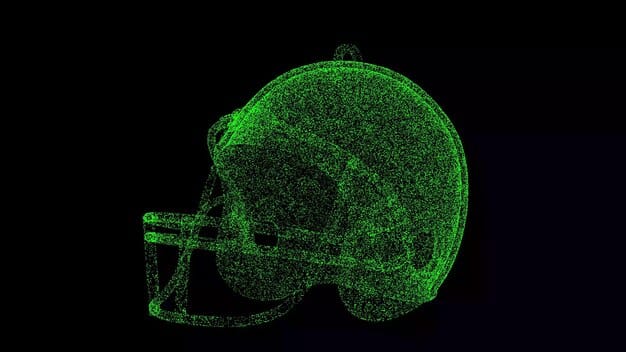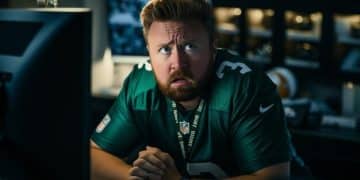How New Concussion Protocols Could Reshape NFL Contracts in 2025

New concussion protocols in the NFL, emphasizing player safety, are poised to significantly influence player contract negotiations by 2025, potentially leading to revised contract structures and increased financial protections for players affected by head injuries.
The landscape of professional football is constantly evolving, and player safety has come to the forefront of concerns. As we look ahead to 2025, understanding how will the new concussion protocols impact NFL player contracts becomes crucial for players, teams, and fans alike.
Understanding the NFL’s Evolving Concussion Protocols
The NFL has a long history of grappling with the issue of concussions. Initially, the understanding and management of head injuries were rudimentary. Over time, however, research, player advocacy, and legal challenges have driven significant changes in how the league addresses concussions. These changes are reflected in the evolving concussion protocols.
The early days of the NFL saw little attention paid to head injuries. Players were often encouraged to “tough it out,” and the long-term consequences of repeated head trauma were largely unknown. As awareness grew, the NFL began to implement baseline cognitive testing and sideline evaluations. But these early measures were often criticized for being insufficient.
Key Milestones in Protocol Development
- The 2009 Mackey-White Health and Safety Committee: This marked a turning point, leading to enhanced sideline evaluations and return-to-play guidelines.
- Independent Neurological Consultants (INCs): Introduced to provide unbiased medical expertise during concussion assessments.
- The Unaffiliated Neurotrauma Consultant (UNC): Added to further ensure player safety by having an independent expert on the sidelines during games.
Current protocols emphasize a multi-step process, including immediate removal from play for any player exhibiting concussion symptoms, comprehensive medical evaluation, and a gradual return-to-play progression. This progression involves increasing levels of physical activity, with each stage requiring medical clearance before advancement. The goal is to ensure that players are fully recovered before returning to the field, minimizing the risk of further injury.
In conclusion, understanding the historical context and key milestones in concussion protocol development is essential for appreciating the potential impact on player contracts in 2025. The league’s ongoing efforts to enhance player safety reflect a commitment to addressing the long-term health consequences of head injuries, setting the stage for contract negotiations to prioritize player well-being.
Projecting Further Enhancements to Concussion Protocols by 2025

Looking ahead, it is anticipated that concussion protocols will continue to evolve. Technological advancements, ongoing research, and a growing emphasis on player safety are likely to drive further enhancements. These future improvements may include more sophisticated diagnostic tools, personalized treatment plans, and stricter return-to-play criteria.
One major area of development is the use of advanced technology. This includes wearable sensors that can detect and measure the severity of head impacts in real time. These sensors can provide valuable data to medical personnel, allowing for quicker and more accurate assessments of potential concussions. Additionally, advancements in neuroimaging techniques, such as functional MRI (fMRI), may offer more detailed insights into the brain’s response to head trauma.
Ongoing research is also playing a crucial role in shaping future concussion protocols. Studies are continuously exploring the long-term effects of concussions, identifying risk factors, and developing more effective treatment strategies. This research not only improves the understanding of concussions but also informs the development of evidence-based guidelines for managing head injuries.
Furthermore, the growing emphasis on player safety is driving a cultural shift within the NFL. Players, coaches, and team owners are increasingly prioritizing the health and well-being of athletes. This shift is fostering a more cautious approach to concussion management, with a greater willingness to err on the side of caution when it comes to returning players to the field.
More stringent return-to-play criteria could also become a reality. This may involve longer recovery periods, more comprehensive cognitive testing, and stricter medical oversight. The goal is to ensure that players are not rushed back into action before they are fully recovered, minimizing the risk of re-injury or long-term health problems.
The projected enhancements to concussion protocols by 2025 are expected to be multifaceted, encompassing technological advancements, research-driven insights, and a cultural shift towards prioritizing player safety. These collective efforts aim to create a safer and more sustainable environment for NFL athletes, ultimately influencing the terms and conditions of player contracts.
The Current Landscape of NFL Player Contracts and Injury Provisions
NFL player contracts are complex agreements that cover various aspects of employment, including salary, bonuses, and benefits. These contracts also typically include provisions related to injuries, which specify how players are compensated and cared for in the event of on-field injuries. Understanding these provisions is essential to assess how new concussion protocols could impact contract negotiations.
Standard NFL player contracts offer certain protections for injured players. The Collective Bargaining Agreement (CBA) between the NFL and the NFL Players Association (NFLPA) outlines minimum requirements for injury benefits, including salary continuation, medical coverage, and disability benefits.
Key Injury-Related Provisions
- Injury Guarantees: Some contracts include injury guarantees, which ensure that players receive a certain portion of their salary, even if they are unable to play due to injury.
- Medical Coverage: Teams are responsible for providing medical care to players who are injured during the course of their employment.
- Disability Benefits: Players who suffer career-ending injuries may be eligible for disability benefits, which provide financial support after their playing careers have ended.
However, not all injuries are treated equally under NFL contracts. Concussions, in particular, can be a complex issue. While the CBA mandates certain protections for all injuries, the specific terms of concussion-related benefits can vary depending on the contract and the circumstances of the injury. Some players may have concussion-specific clauses in their contracts, providing additional protections or benefits.
The current landscape of NFL player contracts and injury provisions reflects a balance between the interests of players and teams. While contracts provide some protections for injured players, there is also a significant emphasis on individual negotiation and contract terms. As concussion protocols continue to evolve, it is likely that these provisions will be further scrutinized and potentially revised to better address the unique challenges posed by head injuries.
In conclusion, the current NFL player contracts offer some protections for injured players, including minimum benefits outlined in the CBA. However, individual contract negotiations and the complexities surrounding concussion-related injuries highlight the need for potential revisions in light of evolving concussion protocols. This sets the stage for contract negotiations to prioritize player well-being and address the long-term health consequences of head injuries.
Potential Impact of Enhanced Protocols on Guaranteed Money

One of the most significant ways in which enhanced concussion protocols could impact NFL player contracts is through the amount of guaranteed money offered to players. Guaranteed money refers to the portion of a player’s contract that is guaranteed, regardless of whether the player is released, injured, or unable to perform.
In today’s NFL, guaranteed money is a valuable and highly sought-after contract provision. It provides players with financial security, ensuring that they will receive a certain amount of compensation, even if their careers are cut short due to injury. However, teams are often hesitant to offer large amounts of guaranteed money, as it represents a significant financial risk.
With the implementation of enhanced concussion protocols, teams may become even more cautious about offering guaranteed money, particularly to players who are at a higher risk of concussion. This could include players who have a history of concussions or who play positions that are more prone to head injuries. Teams may be less willing to commit large sums of guaranteed money to these players, fearing that they could be sidelined by concussions and unable to fulfill their contract obligations.
On the other hand, players and the NFLPA may argue that increased guaranteed money is necessary to compensate players for the increased risk of concussion. They may contend that players who are exposed to a higher risk of head injuries should be entitled to greater financial security, to protect them in the event of a career-ending concussion.
The debate over guaranteed money could lead to some interesting and potentially contentious contract negotiations. One possible outcome is that contracts become more heavily incentivized, with players earning bonuses based on performance and playing time. This would allow teams to mitigate their financial risk while still providing players with the opportunity to earn significant compensation.
Another possibility is that contracts include more specific provisions related to concussions. These provisions could outline the circumstances under which a player would be entitled to guaranteed money in the event of a concussion, as well as the procedures for evaluating and treating head injuries.
In conclusion, one of the most significant ways enhanced concussion protocols could impact NFL player contracts is through the amount of guaranteed money offered to players. The debate over guaranteed money could lead to interesting and potentially contentious contract negotiations and contracts that are more heavily incentivized.
The Rise of Performance-Based Incentives and Concussion Clauses
Given the potential financial risks associated with concussions, teams may look to mitigate those risks by incorporating performance-based incentives and concussion-specific clauses into player contracts. These provisions would link a player’s compensation to their performance on the field, while also addressing the specific risks associated with head injuries.
Performance-based incentives are already a common feature of NFL player contracts. These incentives reward players for achieving certain milestones, such as reaching a certain number of receiving yards, scoring a certain number of touchdowns, or making a certain number of tackles. By tying a portion of a player’s compensation to their performance, teams can ensure that they are only paying players who are contributing to the team’s success.
In the context of concussion protocols, performance-based incentives could be used to reward players for staying healthy and avoiding concussions. For example, a player could earn a bonus for playing a certain number of games without sustaining a concussion. This would incentivize players to take care of themselves and avoid unnecessary risks on the field.
Concussion-specific clauses could also become more prevalent in NFL player contracts. These clauses would outline the specific procedures and benefits that a player would be entitled to in the event of a concussion. For example, a clause could specify the type of medical care that a player would receive, the duration of their salary continuation, and the amount of disability benefits they would be eligible for.
These clauses could also address the issue of pre-existing conditions. If a player has a history of concussions, a concussion-specific clause could outline the steps that would be taken to monitor and manage their condition. This could include regular cognitive testing, restrictions on playing time, and access to specialized medical care.
In conclusion, to mitigate the financial risks associated with concussions, teams may incorporate performance-based incentives and concussion-specific clauses into player contracts. These provisions would link a player’s compensation to their performance on the field, while also addressing the specific risks associated with head injuries.
Long-Term Financial Planning for Players Prone to Concussions
For players who are prone to concussions, long-term financial planning becomes even more critical. These players face a greater risk of career-ending injuries and may need to develop strategies to protect their financial futures. This can involve a variety of measures, including saving aggressively, investing wisely, and obtaining appropriate insurance coverage.
Saving aggressively is essential for players who face an uncertain future due to concussions. These players should aim to save as much of their income as possible, to build a financial cushion that can sustain them in the event of a career-ending injury. This may involve making sacrifices in their lifestyles and prioritizing long-term financial security over short-term gratification.
Investing wisely is also critical. Players who are prone to concussions should seek the advice of a qualified financial advisor to develop an investment strategy that is tailored to their specific needs and circumstances. This may involve diversifying their investments, focusing on low-risk assets, and avoiding speculative investments.
- Disability Insurance: This type of insurance provides income replacement in the event that a player is unable to work due to a disability, including a concussion-related disability.
- Life Insurance: This type of insurance provides financial protection for a player’s family in the event of their death.
- Long-Term Care Insurance: This type of insurance covers the costs of long-term care, such as nursing home care or home health care, which may be necessary for players who suffer severe concussion-related health problems.
It is also important for players who are prone to concussions to have a comprehensive estate plan in place. This plan should outline how their assets will be managed and distributed in the event of their death or incapacity. This can help to ensure that their families are taken care of and that their wishes are carried out.
In conclusion, long-term financial planning is critical for players prone to concussions. These players face a greater risk of career-ending injuries and may need to develop strategies to protect their financial futures, including insurance coverage.
Navigating Contract Negotiations in the Era of Heightened Awareness
As concussion awareness continues to grow, navigating contract negotiations will require a more thoughtful and nuanced approach. Players, agents, and teams must be prepared to address the potential impact of head injuries on a player’s career and financial security. This may involve seeking expert advice, conducting thorough research, and being willing to compromise.
Seeking expert advice is essential for both players and teams. Players should consult with medical professionals to fully understand the risks associated with concussions and to develop strategies for managing their health. They should also seek the advice of financial advisors to develop a long-term financial plan that takes into account the potential impact of head injuries.
Teams should consult with medical experts to assess the concussion risk of potential free agent signings and draft picks. They should also seek the advice of legal experts to ensure that their contracts comply with all applicable laws and regulations.
Conducting thorough research is also important. Players and agents should research the concussion history of potential teams, as well as the team’s approach to concussion management. They should also research the financial security offered by different teams, including the amount of guaranteed money and the availability of disability benefits.
Being willing to compromise is essential for successful contract negotiations. Players and teams must be willing to make concessions to reach an agreement that is fair and equitable. The potential impact of concussions will undoubtedly be a key factor in these negotiations, requiring flexibility and creativity on both sides.
Ultimately, navigating contract negotiations in the era of heightened concussion awareness will require a collaborative and forward-thinking approach. By prioritizing player safety and financial security, players and teams can work together to create contracts that protect the interests of all parties involved.
In conclusion, players, agents, and teams must be prepared to address the potential impact of head injuries on a player’s career and financial security. Players and teams can work together to create contracts that protect the interests of all parties involved.
| Key Point | Brief Description |
|---|---|
| 🧠 Evolving Protocols | NFL’s concussion protocols are continuously improving. |
| 💰 Guaranteed Money | Teams may reduce guaranteed money for concussion-prone players. |
| 💼 Incentives & Clauses | More contracts may include performance incentives and concussion clauses. |
| 🛡️ Financial Planning | Players should plan finances carefully due to concussion risks. |
Frequently Asked Questions
▼
The NFL’s concussion protocols are continuously reviewed and updated based on new research, technology, and medical advice. Updates can occur annually or more frequently if necessary to enhance player safety.
▼
A pre-existing concussion condition refers to a player’s history of one or more concussions prior to signing a new contract or entering the NFL, which may influence contract terms.
▼
While the formal concussion protocols are primarily enforced during the regular season and organized team activities, players are encouraged to report any concussion symptoms year-round.
▼
Concussion clauses can affect the salary cap, particularly if they include guaranteed money that must be accounted for, even if a player is unable to play due to a concussion.
▼
Independent neurologists provide unbiased medical evaluations on the sidelines during games. They ensure player safety by assisting in thorough concussion assessments and return-to-play decisions.
Conclusion
As the NFL continues to prioritize player safety and refine its concussion protocols, the impact on player contracts is expected to be significant. By 2025, players, agents, and teams must be prepared to navigate a landscape where concussion risks are carefully evaluated and contract terms reflect the evolving understanding of head injuries.





